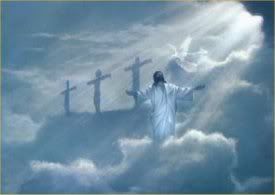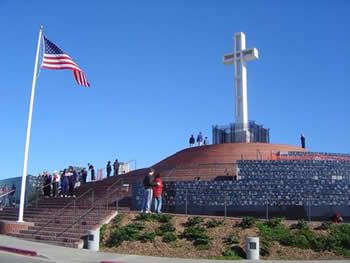 A Catholic Response to The Da Vinci Code
A Catholic Response to The Da Vinci Code
With so much hype going around about this book and movie, I figured it would be nice to give my views on it. I found an interesting pamphlet at mass today, and am going to share it here with you, for discussion purposes only. The pamphlet was produced by OurSundayVisitor. If you would like bulk copies of it, you can contact them at 200 Noll Plaza, Huntington, IN 46750 or by calling 800 348-2440. You can also visit www.osv.com for information. (Pamphlet # P319.) It isn't my intention to plagiarize the work done on this pamphlet, but I firmly believe the authors did an excellent job in researching their facts, and more people read blogs than attend mass looking for info about The Da Vinci Code. All credit goes to Amy Welborn and her research for OurSundayVisitor. For this blog entry, I am merely a humble typist.
_____________________________________________
The Da Vinci Code was first published in 2003 and has remained on or near the top of bestseller lists ever since, reaching tens of millions of readers worldwide. With the release of a film based on the novel, directed by Ron Howard and starring the popular Tom Hanks, the message of The Da Vinci Code will reach millions more.
But what is The Da Vinci Code really all about?
The "code" at the plot's center refers to cryptic messages that the artist supposedly incorporated into his work. Leonardo, as the story goes, was a member of an ancient secret society called the "Priory of Sion." This group was dedicated to preserving the "truth" that Jesus was married to Mary Magdalene and had designated her as the leader of His movement, which is all about the appreciate of the "sacred feminine" in life. The "Code" claims that the legendary "Holy Grail" is really Mary Magdalene, the bloodline of the descendants she and Jesus produced, and the "sacred feminine" that she represents.
The Da Vinci Code film dramatizes these claims in flashback form, gives them life, and will probably prompt even more people to ask: Could the traditional Christian understanding of Jesus be false?
Consider the Sources
The claims about art, history and religion made in The Da Vinci Code are not original, but are all taken from other works. First there are books of pseudo-history (Holy Blood, Holy Grail; The Templar Revelation) from which every bit of the story connecting Jesus, Mary Magdalene, the Holy Grail-as-Mary, and the Priory of Sion are taken.
(Incidentally, the "Priory of Sion" and its list of "grand masters" - as Brown and these other books describe them - have been proven to be frauds originated by a reactionary, anti-Semitic Frenchman in the 1950s.)
Brown also depends on speculative and fictional works about Mary Magdalene (The Woman With the Alabaster Jar), from which he takes the notion of Mary as the designated leader of early Christianity.
Curiously, Brown never refers to any book of the New Testament nor to any of the writing or liturgies of the early Christian Church as he discusses Jesus' identity or what early Christians believed about Jesus.
Was the Son of God Invented?
Both the Da Vinci Code novel and film assert that the early Christians viewed Jesus as merely a "mortal teacher" and that is was only at the Council of Nicaea in 325, under pressure from the Emperor Constantine, that belief in Jesus' divinity became official Christian teaching. This simply is not true. The Gospels and letters of Paul, as well as writings and liturgies from the centuries preceding Nicaea, give ample evidence that Christian faith was based on a belief that Jesus was the Son of God. they worshipped Jesus as Lord.
What Nicaea did was to correct the heresy of Arianism: the belief that Jesus was a highly exalted creature - but a creature, nonetheless - who did not share in God's nature.
(Catholics) repeat the Council's affirmation of Jesus' human and divine natures when we say the Nicene Creed: "God from God, Light from Light, True God from True God." This was not an innovation. It was simply a more precise articulation of the truth about the Jesus we encounter in the Gospels.
Is the Bible Reliable?
In The Da Vinci Code, the scholar Dr. Teabing (played by Sir Ian McKellan) declares that at the time of Nicaea, there were "thousands" of texts documenting a very human life of Jesus. He says that there were 80 gospels in circulation, 80 gospels that give the story of the "original Christ" that Constantine repressed and - if the film is to be believed - personally had burned!
The implication is that during the first three centuries of Christianity, there were many accounts of Jesus' life, all equally reliable, and that the selection of the canon - the books of the New Testament determined to be inspired by the Holy Spirit and to be used by the entire Church - was based on nothing but a desire for power.
This is not true. First, there were not "thousands" of such texts. There were certainly more than are contained in the Bible, but relatively few with any confirmed link to apostolic times. Further, by the middle of the second century, Christian writers regularly cited the Gospels of Matthew, Mark, Luke, and John, as well as Paul's letters, as the most reliable sources of information about Jesus' life and the faith of the apostles. And, contrary to Brown's story, it wasn't under Constantine that the canon of Scripture was formally accepted. That happened at Church councils decades later, after a great deal of prayer and debate.
For his part, Brown launches his fictional account from texts that were produced by heretical groups in the late second through fifth centuries as more reliable sources for this "original Christ." But most scholars agree these text have no value in understanding Jesus or apostolic Christianity.
Was Jesus Married?
The story of The Da Vinci Code asserts that Jesus must have been married because that was the norm for Jewish men at the time, and He wouldn't have been taken seriously as a religious teacher if He had not been married.
The Gospels do not describe Jesus as being married. They describe and name His parents, other family members, and even women whom Luke says accompanied Him and the apostles:
And the twelve were with him, and also some women who had been healed of evil spirits and infirmities: Mary, called magdalene, from whom seven demons had gone out, and Joanna, the wife of Chuza, Herod's steward, and Susanna, and many others, who provided for them out of their means. - Lk 8:2-3, RSV
The Gospels describe Jesus' interaction with the people of His hometown. If Jesus had been married, given the frequency with which other relations are mentioned, the marriage would have been mentioned as well. there would be no reason not to.
Secondly, being unmarried would not have diminished Jesus' authority as a Jewish teacher. Certain Jewish prophets, Jeremiah amount them, were unmarried. John the Baptist was unmarried, as was Paul; and, during the first century, an entire community of Jewish celibates, called the Essenes, lived near the Dead Sea.
In other words, while being unmarried would have been unusual for a Jewish man, it would not be unheard of, especially for a man totally consumed by dedication to God.
What About Mary Magdalene?
Brown says that Mary Magdalene was of royal blood, of the tribe of Benjamin, and Jesus' wife. According to his story, after the Crucifixion, Mary, pregnant with Jesus' child, moved to France and became the root of the Merovingian royal family.
He also says that Jesus intended Mary to be the head of His church, but that Peter seized power from her, suppressed all evidence of Jesus' real intentions, and set into motion a 2,000-year conspiracy to demonize Mary Magdalene.
But belying that assertion is the fact that Mary Magdalene is honored as a saint in both the Catholic and Orthodox Churches - so one wonders what basis he has for the accusation that she's been "demonized." Mary is honored in Christianity for her faithfulness to Jesus and her role as witness at the empty tomb. Orthodox Christians cal her "Equal-to-the-Apostles" for this reason - not because she led any alternative branch of Christianity in competition with Peter. While legends from Western Christianity describe her as evangelizing southern France, no legend mentions any power struggle or any "alternative" Christian group. If she had led such a body, and if Peter's branch was so anxious to suppress her, it hardly makes sense that they would retain the portions of the Gospels describing her a the first to meet the Risen Christ!
Messages In The Paintings?
Brown claims that Leonardo Da Vinci communicated this "truth" about Jesus and Mary Magdalene in his work, and gives several examples to make his point. But it's hard to believe what Brown says about this art, considering how regularly he incorrectly describes the content of the painting and garbles the historical background behind them.
He write, for example, that the John in "The Last Supper" is too feminine-looking to be a man (thereby concluding it is meant to be Mary Magdalene). However, it was traditional during the time when Leonardo painted "The Last Supper" to represent John as a beardless attractive youth.
Brown says that since there is no Last Supper chalice or "grail", the "grail" must be Mary Magdalene. However, there is not chalice in the painting because it portrays a scene from the gospel of John )13:21-25) in which the Institution of the Eucharist is not described, and the Last Supper is not specifies as a Passover Meal - hence, no central chalice.
Opus Dei
Opus Dei, a central element in The Da Vinci Code, is characterized as a radical, cult-like fringe group, associated with the Catholic Church. In the story, this group is all about control and repression of the truth. However, this depiction, in both novel and film, is not only inaccurate but unjust. What are the facts?
- Opus Dei ("Work of God") was founded by St. Josemaria Escriva, in Spain, in 1928.
- It is an institution fully approved by, and part of, the Catholic Church, with a mission to help lay people develop their spiritual lives.
- It involves a number of different levels of membership. Some associated with Opus Dei benefit from its retreats and spiritual direction while living completely in the world at secular jobs, with families. Others live in Opus Dei houses and commit to celibacy.
- There are priests associated with Opus Dei, but there are definitely no monks.
- Opus Dei runs many institutions throughout the world dedicated to education, spiritual development, and healthcare.
The Da Vinci Code's portrayal of Opus Dei is not even a caricature; it is a fabrication. More can be found at the group's website: http://www.opusdei.org.
For More Information:
http://www.osv.com/davinci for other articles on The Da Vinci Code.

 Posted by
Posted by
 Labels:
Labels:






